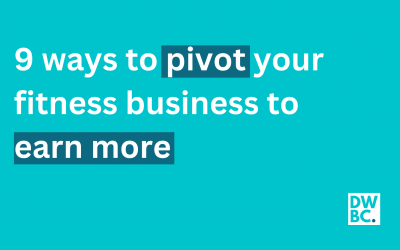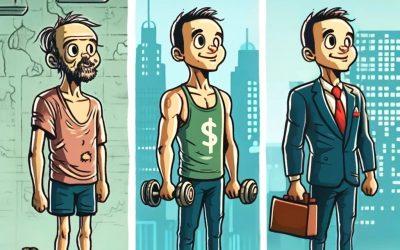Habits drive our behaviours. 45% of everything you do in life is a habit. These are behaviours that require no conscious thought. No decision making. No choice. These are the behaviours that operate on autopilot. Habits save energy for the brain by removing the need to make a decision to do something and instead making it automatic.
Our ‘non-habit’ behaviours live in our pre-frontal cortex, the higher order ‘human’ part of our brain. Our habitual behaviours live in another part of our brain, our basal ganglia.
Our mind doesn’t show prejudice. Maybe it’s a good habit like getting to bed by 9.30am. Maybe it’s a bad habit like smoking. As far as your brain is concerned, these things are just firings of electrical impulses along the neurons in our head. It takes the higher order decision-making centres of our brain, like our pre-frontal cortex, to determine whether the outcome of these electrical impulses is positive or negative.
So we get to choose which of our behaviours become habit by how often we complete these behaviours. You see, habit is like a muscle. The more we complete an action, the more the neural pathways in our brain ‘thicken’. The thicker the pathway, the more easily the traffic flows, and the less resistance there is to completing a certain behaviour. And thus we have a habit.
The challenge here is two-fold:
- We need to make sure the behaviours we’re repeating are positive behaviours we WANT to turn automatic.
- We need to repeat these behaviours enough that they switch from the 55% of our actions that require decision (in our pre-frontal cortex) to the 45% of our actions that run on autopilot (in our basal ganglia).
So how do we do this?
Early research pointed to a simplistic model of habit formation. There were three steps.
- Find a cue.
- Complete the behaviour.
- Reward the behaviour.
The belief was that the cue was something that would initiate a behaviour. Maybe the cue to go to the gym in the morning is layout out your exercise clothes the night before. The cue to eat a healthy dinner could be pre-preparing the meal on the weekend when your willpower to make healthy choices wasn’t depleted. Then the reward was the prize for completing that behaviour. Maybe the reward was the feelings of accomplishment and that healthy feeling of muscle soreness after exercise, or the weight loss you experience from sticking with your healthy way of eating.
Cue the behaviour, complete the behaviour, reward the behaviour.
Bu there was something missing, because it’s human nature to avoid things they dislike in the short term, even if there’s a long term benefit. This is why people have trouble saving money, exercising regularly, or eating healthy.
So this missing link might just be the key to habit formation.
The missing link was anticipation.
To understand how this missing link works, and how we can use it to build habits, we have to travel inside the brain. Before a behaviour becomes a habit, we see a certain pattern in the brain. The pleasure centres in the brain light up when the individual gets a reward. In our examples, the ‘pre-habit’ brains would light up with the post- workout feelings of accomplishment, or the reducing waist-line. The reward creates happiness.
However, something very interesting happens when this cycle of cue, behaviour, reward is repeated enough times. Instead of the happiness centres of the brain lighting up when the individual is rewarded, they light up with the cue. The anticipation of the reward becomes enough to fire these areas of the brain. And you develop a craving. So instead of post exercise satisfaction or weight loss making you happy, the exercise and healthy diet makes you happy. Your happiness is a result of your habits. If you’ve chosen to develop healthy, positive habits, health = happiness.
And when this switch happens, when the happiness comes from the cue rather than the reward, we have a habit. We’ve shifted that behaviour into the 45% of everything we do that runs on autopilot.
YOU BEGIN TO CRAVE THE BEHAVIOUR.
Of course the opposite is also true. The thought of the nicotine hit from smoking a cigarette or the relaxation of downing a cold beer after work can make you happy. This just shows how important it is to guard the gates to your basal ganglia, to guard the gates to the habit centre of your brain.
But what happens if the reward is then removed? This can cause a problem. Sure, you’ve completed an action and that action has made you happy (in anticipation). But what if that anticipation is left unfulfilled? Your mind is waiting for the loop to be closed, for the cue, behaviour, reward to be resolved. With no resolution comes states of disappointment and sadness, even anxiety and depression.
So the cue creates a craving. A craving for the reward, and the expectation that the reward will be won. It is this craving of reward that makes a behaviour a habit.
If the behaviour is a negative one, this can be dangerous. The thought of smoking (or being exposed to cigarettes or other smokers) makes a habitual smoker happy. They’re happy because of the anticipation of the reward. Withhold that reward and the desire and craving becomes so strong that the individual either becomes unhappy and depressed, or they succumb to their habit and light up a cigarette.
SO how can we use this understanding of the habit loop to create positive behaviour change?
Firstly we need a cue. And this cue needs to be so small, and so easy to complete that there’s no reason you wouldn’t do it. Laying out your workout clothes before bed. Then, you need a reward. Maybe it’s the rush of feel good chemicals in your body after exercise, or maybe it’s getting to tick the box of another exercise session completed. Before your behaviour becomes a habit, this endorphin rush, or the ticking of the box, is what will make you happy. And finally, you need to repeat that process of cue-reward enough times that your mind begins to expect the reward and lights up with happy chemicals at the cue, not at the reward. The cue then triggers the craving, the craving makes that behaviour a habit.




